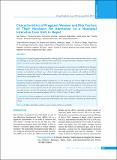Please use this identifier to cite or link to this item:
https://hdl.handle.net/20.500.14356/880Full metadata record
| DC Field | Value | Language |
|---|---|---|
| dc.contributor.author | Pokhrel, Sabi | - |
| dc.contributor.author | Shrestha, Dhruba | - |
| dc.contributor.author | Shrestha, Raj Kumar | - |
| dc.contributor.author | Budhathoki, Saraswati | - |
| dc.contributor.author | Sah, Ashok Kumar | - |
| dc.contributor.author | Parajuli, Pramila | - |
| dc.contributor.author | Raya, Ganendra Bhakta | - |
| dc.contributor.author | Morimoto, Konosuke | - |
| dc.contributor.author | Dhoubhadel, Bhim Gopal | - |
| dc.date.accessioned | 2023-04-03T06:48:06Z | - |
| dc.date.available | 2023-04-03T06:48:06Z | - |
| dc.date.issued | 2022 | - |
| dc.identifier.citation | PokhrelS., ShresthaD., ShresthaR. K., BudhathokiS., SahA. K., ParajuliP., RayaG. B., MorimotoK., & DhoubhadelB. G. (2022). Characteristics of Pregnant Women and Risk Factors of Their Newborn for Admission to a Neonatal Intensive Care Unit in Nepal. Journal of Nepal Health Research Council, 20(02), 289-295. | en_US |
| dc.identifier.issn | Print ISSN: 1727-5482; Online ISSN: 1999-6217 | - |
| dc.identifier.uri | http://103.69.126.140:8080/handle/20.500.14356/880 | - |
| dc.description.abstract | Abstract Background: Nepal has progressed gradually in reducing under-5 mortality and neonatal mortality; however, they are still high at 30.8 and 19.8 per 1000 live births, respectively. Neonatal mortality constituted about 64% of the under-5 mortality in 2019, higher than the global average of 47%. Methods: This is a prospective study among pregnant women and their newborn babies in Siddhi Memorial Hospital, Bhaktapur, Nepal, from October 2017 to April 2018. Demographic and clinical data, high vaginal swabs of pregnant mothers, and umbilical cord blood were collected. High vaginal swabs were cultured, and umbilical cord blood samples were cultured and tested for inflammatory markers. After discharge to home, neonates were followed for 28 days of life by weekly phone calls. Results: Total number of pregnant mothers enrolled was 151. The median age was 26 years (IQR: 18-40), and the proportion of adolescent mothers was 4.7%. Half of the deliveries were done by the caesarian section, and 8.6% had gestational age <37 weeks. High vaginal swab cultures were positive in 8.2% of the samples (n=135), and Escherichia coli was the most common bacteria. Out of 153 newborn babies (2 were twins), 8 (5.2%) were admitted to the neonatal intensive care unit. The proportion of low birth weight was 13%, and it was independently associated with neonatal intensive care unit admission (adjusted OR=9.4, 95%CI 1.8-50.1; P value= 0.009). Conclusions: Adolescent pregnancies and Low Birth Weight babies were commonly observed. Both of these issues need to be addressed by effective measures that would improve the current situation of maternal and child health in Nepal. Keywords: Maternal health; morbidity neonates; Nepal; risk factors; morbidity | en_US |
| dc.language.iso | en | en_US |
| dc.publisher | Nepal Health Research Council | en_US |
| dc.relation.ispartofseries | April-June, 2022; | - |
| dc.subject | Maternal health | en_US |
| dc.subject | morbidity neonates | en_US |
| dc.subject | Nepal | en_US |
| dc.subject | risk factors | en_US |
| dc.subject | morbidity | en_US |
| dc.title | Characteristics of Pregnant Women and Risk Factors of Their Newborn for Admission to a Neonatal Intensive Care Unit in Nepal | en_US |
| dc.type | Journal Article | en_US |
| Appears in Collections: | Vol 20 No 02 Issue 55 April-June, 2022 | |
Files in This Item:
| File | Description | Size | Format | |
|---|---|---|---|---|
| 3824-Manuscript-29669-2-10-20221103.pdf | Full Article | 375.9 kB | Adobe PDF |  View/Open |
Items in DSpace are protected by copyright, with all rights reserved, unless otherwise indicated.
